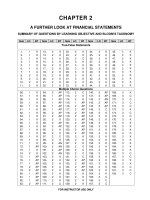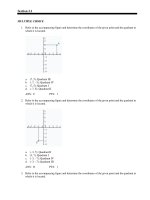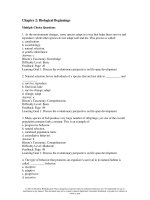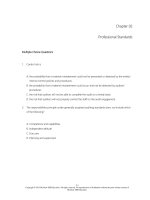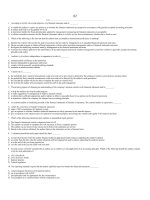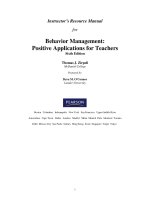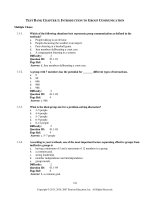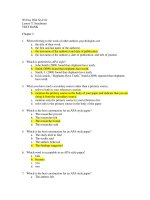JavaScript the web warrior series 6th edition vodnik test bank
Bạn đang xem bản rút gọn của tài liệu. Xem và tải ngay bản đầy đủ của tài liệu tại đây (230.19 KB, 9 trang )
Name:
Class:
Date:
Chapter 02: Working with Functions, Data Types, and Operators
True / False
1. In JavaScript code, you use the words yes and no to indicate Boolean values.
a. True
b. False
ANSWER:
False
POINTS:
1
REFERENCES: 97
2. A comparison operator is used to compare two operands and determine if one numeric value is greater than another.
a. True
b. False
ANSWER:
True
POINTS:
1
REFERENCES: 118
3. A logical operator is used to compare two string operands for equality.
a. True
b. False
ANSWER:
False
POINTS:
1
REFERENCES: 123
4. Parentheses are used with expressions to change the associativity with which individual operations in an expression are
evaluated.
a. True
b. False
ANSWER:
True
POINTS:
1
REFERENCES: 129
130
5. An anonymous function is a set of related statements that is assigned a name.
a. True
b. False
ANSWER:
False
POINTS:
1
REFERENCES: 74
Multiple Choice
6. In JavaScript programming, you can write your own procedures, called ____, which refer to a related group of
JavaScript statements that are executed as a single unit.
a. programs
b. functions
c. modules
d. objects
Cengage Learning Testing, Powered by Cognero
Page 1
Name:
Class:
Date:
Chapter 02: Working with Functions, Data Types, and Operators
ANSWER:
b
POINTS:
1
REFERENCES: 73
74
7. A(n) ____ is a variable that is used within a function.
a. method
b. property
c. parameter
d. operator
ANSWER:
c
POINTS:
1
REFERENCES: 75
8. A(n) ____ statement is a statement that returns a value to the statement that called the function.
a. return
b. replace
c. value
d. exit
ANSWER:
a
POINTS:
1
REFERENCES: 86
9. A ____ variable is one that is declared outside a function and is available to all parts of your program.
a. local
b. limited
c. scoped
d. global
ANSWER:
d
POINTS:
1
REFERENCES: 87
10. Data types that can be assigned only a single value are called ____ types.
a. primitive
b. null
c. numeric
d. Boolean
ANSWER:
a
POINTS:
1
REFERENCES: 91
11. Programming languages that require you to declare the data types of variables are called ____ typed programming
languages.
a. dynamic
b. strongly
c. static
d. loosely
ANSWER:
b
POINTS:
1
REFERENCES: 92
93
12. JavaScript is a ____ programming language.
a. static typed
b. loosely typed
Cengage Learning Testing, Powered by Cognero
Page 2
Name:
Class:
Date:
Chapter 02: Working with Functions, Data Types, and Operators
c. strongly typed
ANSWER:
b
POINTS:
1
REFERENCES: 93
d. numeric typed
13. A(n) ____ is a positive or negative number with no decimal places.
a. floating-point number
b. scientific number
c. exponential number
d. integer
ANSWER:
d
POINTS:
1
REFERENCES: 93
14. A literal string can be assigned a zero-length string value called a(n) ____ string.
a. empty
b. undefined
c. short
d. byte
ANSWER:
a
POINTS:
1
REFERENCES: 98
15. You can use the compound ____ to combine two strings.
a. value separator
b. equals comparison
c. assignment operator
d. declaration operator
ANSWER:
c
POINTS:
1
REFERENCES: 100
16. A(n) ____ tells the compiler or interpreter that the character that follows it has a special purpose.
a. exclamation point
b. escape character
c. null character
d. upper case character
ANSWER:
b
POINTS:
1
REFERENCES: 101
17. The strict equal operator is ____.
a. =
b. ==
c. ===
d. !=
ANSWER:
c
POINTS:
1
REFERENCES: 104
118
119
18. You can use an arithmetic operator to return the modulus of a calculation, which is the ____ when you divide one
number by another number.
Cengage Learning Testing, Powered by Cognero
Page 3
Name:
Class:
Date:
Chapter 02: Working with Functions, Data Types, and Operators
a. remainder left
c. product
ANSWER:
a
POINTS:
1
REFERENCES: 105
b. quotient
d. difference
19. The And operator is ____.
a. !=
b. ||
c. &&
d. ===
ANSWER:
c
POINTS:
1
REFERENCES: 104
123
124
20. The ____ operator executes one of two expressions based on the results of a conditional expression.
a. .
b. ()
c. ,
d. ?:
ANSWER:
d
POINTS:
1
REFERENCES: 125
21. Which arithmetic operators have the highest precedence?
a. * / %
b. < <=
c. &&
d. + ANSWER:
a
POINTS:
1
REFERENCES: 127
128
22. Which of the following is a logical operator?
a. ++
b. ()
c. ==
d. ||
ANSWER:
d
POINTS:
1
REFERENCES: 123
124
23. Which of the following is a falsy value?
a. true
b. -1
c. 0
d. 1
ANSWER:
c
POINTS:
1
REFERENCES: 122
Cengage Learning Testing, Powered by Cognero
Page 4
Name:
Class:
Date:
Chapter 02: Working with Functions, Data Types, and Operators
123
24. Function statements are contained within the function ____.
a. parameters
b. braces
c. arguments
d. parentheses
ANSWER:
b
POINTS:
1
REFERENCES: 75
25. The variables or values that you place in the parentheses of a function call statement are called ____.
a. string operators
b. primitive types
c. arguments
d. event listeners
ANSWER:
a
POINTS:
1
REFERENCES: 79
Completion
26. Placing a parameter name within the parentheses of a function definition is the equivalent of declaring a new
____________________.
ANSWER:
variable
POINTS:
1
REFERENCES: 75
27. A(n) ____________________ type is the specific category of information that a variable contains.
ANSWER:
data
POINTS:
1
REFERENCES: 91
28. Sending arguments to the parameters of a called function is called ____________________ arguments.
ANSWER:
passing
POINTS:
1
REFERENCES: 79
29. A(n) ____________________ variable is declared inside a function and is available only within the function in which
it is declared.
ANSWER:
local
POINTS:
1
REFERENCES: 87
30. A(n) ____________________ operator requires an operand before and after the operator.
ANSWER:
binary
POINTS:
1
REFERENCES: 105
Cengage Learning Testing, Powered by Cognero
Page 5
Name:
Class:
Date:
Chapter 02: Working with Functions, Data Types, and Operators
Matching
Identify the letter of the choice that best matches the phrase or definition.
a. addEventListener()
b. function call
c. postfix operator
d. scope
e. Boolean
f. function definition
g. operator precedence
h. floating-point
i. falsy
j. innerHTML
REFERENCES: 81
79
109
87
97
74
127
93
122
116
31. Method that lets you specify an event handler for an event
ANSWER: a
POINTS: 1
32. The lines that make up a function
ANSWER: f
POINTS: 1
33. A logical value of true or false
ANSWER: e
POINTS: 1
34. The code that invokes a named function
ANSWER: b
POINTS: 1
35. Can be either global or local
ANSWER: d
POINTS: 1
36. A number that contains decimal places or that is written in exponential notation
ANSWER: h
Cengage Learning Testing, Powered by Cognero
Page 6
Name:
Class:
Date:
Chapter 02: Working with Functions, Data Types, and Operators
POINTS: 1
37. A value treated in comparison operations as the Boolean value false
ANSWER: i
POINTS: 1
38. Placed after a variable
ANSWER: c
POINTS: 1
39. The order in which operations in an expression are evaluated
ANSWER: g
POINTS: 1
40. A property whose value is the content between an element's opening and closing tags
ANSWER: j
POINTS: 1
Subjective Short Answer
41. Describe the two types of functions and explain when you'd use each type.
ANSWER:
JavaScript supports two different kinds of functions: named functions and anonymous functions. A
named function is a set of related statements that is assigned a name. You can use this name to reference,
or call, this set of statements in other parts of your code. An anonymous function, on the other hand, is a
set of related statements with no name assigned to it. The statements in an anonymous function work
only in a single context—the place in the code where they are located. You cannot reference an
anonymous function anywhere else in your code.
Generally, you use a named function when you want to be able to reuse the function statements within
your code, and you use an anonymous function for statements that you need to run only once.
POINTS:
1
REFERENCES: 74
42. Define variable scope, and describe the two types of variable scope and how you create each.
ANSWER:
When you use a variable in a JavaScript program, particularly a complex JavaScript program, you need
to be aware of the variable scope—that is, you need to think about where in your code a declared
variable can be used. A variable’s scope can be either global or local. A global variable is one that is
declared outside a function and is available to all parts of your code. A local variable is declared inside a
function and is available only within the function in which it is declared. Local variables cease to exist
when a function ends. If you attempt to use a local variable outside the function in which it is declared,
browsers log an error message to the console.
POINTS:
1
REFERENCES: 87
43. JavaScript supports five primitive data types. Name and describe these types.
ANSWER:
Number: Positive or negative numbers with or without decimal places, or numbers written using
exponential notation.
Cengage Learning Testing, Powered by Cognero
Page 7
Name:
Class:
Date:
Chapter 02: Working with Functions, Data Types, and Operators
Boolean: A logical value of true or false.
String: Text such as "Hello World".
Undefined: A variable that has never had a value assigned to it, has not been declared, or does not exist.
Null: An empty value.
POINTS:
1
REFERENCES: 91
44. Operator precedence is the system that determines the order in which operations in an expression are evaluated.
ANSWER:
The term operator precedence refers to the order in which operations in an expression are evaluated.
POINTS:
1
REFERENCES: 127
45. What is a browser console and how is it useful for a web developer?
ANSWER:
When a browser encounters an error that keeps it from understanding code, it generates an error
message. However, this message is displayed in a pane known as a browser console, or simply console,
which is hidden by default to avoid alarming users. As a developer, however, it can be useful to display
the browser console pane to see any errors that your code may generate.
POINTS:
1
REFERENCES: 83
46. What is the relationship between Boolean values, truthy values, and falsy values?
ANSWER:
A Boolean value is a logical value of true or false. You can also think of a Boolean value as being yes or
no, or on or off. Boolean values are most often used for deciding which code should execute and for
comparing data. In JavaScript programming, you can only use the words true and false to indicate
Boolean values.
JavaScript includes six values that are treated in comparison operations as the Boolean value false.
These six values, known as falsy values, are "", -0, 0, NaN, null, and undefined. All values other
than these six falsy values are the equivalent of Boolean true, and are known as truthy values.
POINTS:
1
REFERENCES: 97
122
123
47. What is the difference between the operation of the + operator with numbers and with strings? Provide an example of
each, including the results.
ANSWER:
When used with numbers, the + operator adds the operands. For instance, the statement 5 + 3 would
produce the result 8.
When used with strings, the + operator concatenates the operands. For instance, the statement "side" +
"walk" would produce the result "sidewalk".
POINTS:
1
REFERENCES: 100
106
48. What are the differences between using a the increment and decrement unary operators as prefix operators versus
using them as postfix operators?
Cengage Learning Testing, Powered by Cognero
Page 8
Name:
Class:
Date:
Chapter 02: Working with Functions, Data Types, and Operators
ANSWER:
The increment (++) and decrement (--) unary operators can be used as prefix or postfix operators. A
prefix operator is placed before a variable name. A postfix operator is placed after a variable name. The
operands ++count and count++ both increase the count variable by one. However, the two
statements return different values. When you use the increment operator as a prefix operator, the value of
the operand is returned after it is increased by a value of one. When you use the increment operator as a
postfix operator, the value of the operand is returned before it is increased by a value of one. Similarly,
when you use the decrement operator as a prefix operator, the value of the operand is returned after it is
decreased by a value of one, and when you use the decrement operator as a postfix operator, the value of
the operand is returned before it is decreased by a value of one. If you intend to assign the incremented
or decremented value to another variable, then whether you use the prefix or postfix operator makes a
difference.
POINTS:
1
REFERENCES: 109
49. Explain what logical operators are, and then list the 3 JavaScript logical operators and explain what each does.
ANSWER:
Logical operators are used to modify Boolean values or specify the relationship between operands in an
expression that results in a Boolean value.
&& (And) returns true if both the left operand and right operand return a value of true; otherwise, it
returns a value of false
|| (Or) returns true if either the left operand or right operand returns a value of true; if neither
operand returns a value of true, then the expression containing the || operator returns a value of
false
! (Not) returns true if an expression is false, and returns false if an expression is true
POINTS:
1
REFERENCES: 123
124
50. What are the advantages of using the addEventListener() method instead of the other two methods to specify
an event handler?
ANSWER:
One drawback of specifying event handlers with HTML attributes is they require developers to place
JavaScript code within HTML code. Just as developers generally avoid using inline CSS styles to keep
HTML and CSS code separate, most developers prefer not to mix HTML and JavaScript code in the
same file. Instead, they maintain separate HTML and JavaScript files.
When you specify an event handler as a property value for the object representing an HTML element,
you can assign only one event handler per event. In more complex code, you might want to specify
several event handlers to fire in response to a given event.
Using addEventListener() lets you keep your JavaScript code separate from your HTML, and
allows you to specify more than one event handler for a given event on a single element.
POINTS:
1
REFERENCES: 80
81
Cengage Learning Testing, Powered by Cognero
Page 9
